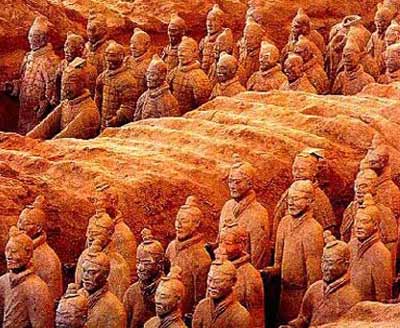| Tools: Save | Print | E-mail | Most Read |
| Relic Swap for Old Times' Sake |
| Adjust font size: |
More than 20 terracotta sculptures from the mausoleum of China's first emperor will be shown at the British Museum this September. "This first emperor is fascinating and we are truly excited about the arrival of the terracottas from Xi'an," Neil MacGregor, director of the British Museum, told China Daily. In addition to the sculptures, English clocks from the royal collection of the Qing Dynasty (1644-1911) will travel from the Palace Museum in Beijing to London. Exchange programs like this started with the Britain Meet the World exhibition, which is ongoing in Beijing. The idea of bringing 18th-century British history to China first came up in 2004, when MaGregor and Li Ji, managing director of the Palace Museum in Beijing, met to discuss possible joint projects. "We browsed through the collections of the British Museum, and both were fascinated by the idea that there was somehow a parallel between the Britain of 200 years ago and the China of today, that is, the economic prosperity and an enthusiasm for meeting the world," said MacGregor. From the talks, the decision was made to stage an exhibition of works from Georgian Britain (from 1714 to 1830), a period that witnessed the Enlightenment and the Industrial Revolution. The funding was no problem: A member of the British Museum's board of trustees was from the family of Robert Ho, the Hong Kong real estate icon, and he proposed that his family foundation sponsor the project. The Robert H. N. Ho Family Foundation is a charitable organization that was established in HK in 2005. Its mission is to foster and promote Chinese arts and culture, and Buddhist philosophy worldwide. "We are most pleased to be the sponsor of this unique and inspiring exhibition, as it provides a rare glimpse into Britain as the emerging power that it was back in the 18th and 19th centuries," Ho said. "The fresh perspectives this exhibition offers will no doubt be a great learning experience for us all in the way we see history, China, ourselves, and the world today." Ho also pledged that his foundation will play an even more prominent role in the coming years to support even more international exhibitions. Among a dozen projects sponsored by the foundation, one of the most influential was the modernized version of the classic Kunqu opera Peony Pavilion. "We are looking forward to working with institutions around the world that share a real passion for Chinese arts and culture," said Caroline Pfohl-Ho, president of the foundation.
(China Daily March 16, 2007) |
| Tools: Save | Print | E-mail | Most Read |
 |
| Related Stories |
|
